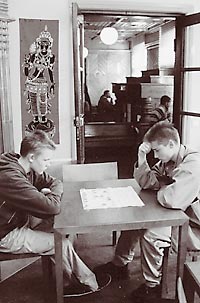
A short introduction to the most common xiangqi openings
Some
of the most important xiangqi
openings are introduced here. The purpose is to help new players to get
started
with the game. This kind of short introduction
can
naturally not be very comprehensive. It only contains few examples of
the most
common opening variations. Some openings have been introduced with only
one
line. Our source of information has been Chinese opening books. We have
used
the Chinese notation system and the names and the abbreviations for the
pieces
follow the WXF (World Xiangqi Federation) standard. (K=King, R=Chariot,
H=Horse,
C=Cannon, E=Elephant, A=Advisor, P=Pawn) The names for the openings
follow the
practice of English xiangqi books. In some cases the Chinese names have
also
been mentioned.
The
xiangqi openings follow the same principles
as the chess openings. There are naturally also some differences. The
most
important thing in the opening is the quick development of the pieces.
Moving
the center pawn (P5+1) in the opening, which is common in chess, is a
mistake
in xiangqi. After the reply C2=5 (or C8=5) red loses his center pawn!
The
center line is strategically important but moving the center pawn makes
sense
only later when the player is ready to attack. Moving the 3. or 7. line
(c and
g line in algebraic notation) pawn is a useful development move because
after
that the horse can advance to the center and the pawn move hinders the
corresponding opponent move. The important question is how to arrange
the
horses, cannons and elephants on the 3. rank. The chariots should be
developed
as soon as possible.
The
most popular and aggressive opening
move is 1.C2=5. It has been estimated that about 70% of all games begin
with
this move. The cannon threatens the opponents center pawn and it
prepares for
the attack. Attempting to win material and neglecting the development
with
moves like 1.C2=3 can be a dangerous waste of time.
Black
has four very popular and reliable
defences against the central cannon opening.
”Screen horses” aka
“Two horses defence” (Ping Feng Ma) is the most popular black defence.
Black
moves both of his horses between the cannons to protect the center
pawn. This
opening has several variations.
”Fan Gong Ma” (The
name is difficult to translate) is another opening where black
developes both
his horses towards the center but one of the cannon is paced on the
palace
corner between the horses. black can now connect his elephants. This
opening is relatively new. Red has several ways to attack
but the black position is solid.
”Same direction
Cannon” opening starts with
the moves 1.C2=5, C8=5. Black replies with
a symmetrical move. This cannon move is possible
because the immediate capture of the
defenceless center pawn with 2.C5+4 loses time and black gets the
initiative.
This capture is only played by amateurs.
”Opposite direction
Cannon” opening starts with the moves 1.C2=5, C2=5. Here red and black
move
their cannons to the opposite directions. The modern practice is to
make the
black cannon move later. (“Delayed opposite direction Cannon”).
The
fifth interesting alternative is ”The Three Step
Tiger” opening. This name refers to the system
where the player develops his chariot quickly by moving the cannon to
the edge
of the board. (For example with the moves H2+3, C2=1 and R1=2) This way of development can lead to other
openings
Other defences
against the central cannon are rare.
Red
naturally has other opening moves
besides the central cannon. These systems are sometimes called “Soft
openings”
because the opening move is not a threat.
”The pawn opening”
(1.P7+1) is a very flexible system. The red opening move is a useful
development move but all the choises concerning piece development are
still
open. Black usually does not answer with the central cannon because red
could
then play any of the central cannon openings with colors reversed and
the pawn
move would be an extra advantage.
”The elephant
opening” (1.E3+5) is a very solid opening where red first protects his
King by
connecting the elephants.
”The horse opening”
(1.H2+3) starts with a natural development move. Red can play the Two
horse
defence, The Fan Gong Ma or Three step tiger opening with the colors
reversed.
Red can also play
his cannon to the front corner of the palace with the move 1.C2=4
(”Palcorner
Cannon”) or 1.C2=6 (“Crosspalace Cannon”). These moves are also
useful developing moves.
Other red opening
moves like 1.H8+9 (”Edge Horse”), 1.C2=3 or 1.C2=7 are very rare.
Chess
grandmaster Robert Hubner, who has
also played Chinese chess, has said that the Chinese chess does not
have as
much opening theory as chess but there is more endgame theory.
Olavi Stenman and
Timo Aitta
THE
MOST COMMON XIANGQI OPENINGS (17.1.2007 / TA,OS)
1) Central Cannon Openings
Two horse defence, Screen horses 1. C2=5 H8+7 2.
H2+3 R9=8
3. P7+1 P7+1
4. H8+7 H2+3 5.
R1+1 /C8+2 /C8=9
3. R1=2 P7+1
4. P7+1 C8+4 5.
H8+7 E3+5 /C2=5
4. R2+6 H2+3 5.
P5+1 A4+5
5. C8=6 R1=2
6. H8+7 C2=1
7. P5+1
5. H8+7 P3+1 6.
R9+1 C2+1 7. R2-2 E3+5 8. P3+1 /P7+1 /R9=6 (“Two headed
H2+3 4.
P3+1 P3+1 5. C8+4 E7+5
/H3+2 snake“)
5. H8+9 E3+5 6.
C8+4
E7+5 6. R9+1
P1+1 6. C8=7
H3+2 7. R9+1 P1+1 /E7+5
/E3+5
4. H8+9 P7+1 5.
C8=6 R1=2 6. R9=8 C2+4 7. R2+4 C8=9
8.
R2=4
5. C8=7 R1=2 6.
R9=8 C2+4 / C2+2 /C8+4
4.
P7+1 P7+1 5. C8=7 C8+2 6.
H8+9
C2+4 6.
R2+4
5. H8+7 E3+5 6.
C8+2
C8+2 6.
H7+6
C2+4 6.
R2+4 C2=7 7. E3+1
6. P5+1 C8+4
(“River crossed cannons”)
5. R2+6 R1+1 6. H8+7 /C8=7
H7+6 6. H8+7 E3+5/R1+1/P7+1
C2+4 6. P5+1 E3+5
7.H8+7 A4+5 8.
R9+1/C8=9
A4+5 6. H8+7 /C8=7
C8=9 6.
R2=3 R8+2 7. H8+7 E3+5
(“Edge
cannon”)
C9-1 7. P5+1
/H8+9/C8=6
7. H8+7 R1+1
8. C8=9
A4+5 8.
H7+6/C8=9
Delayed opposite direction cannon 1. C2=5
H8+7 2.
H2+3 R9=8 3. R1=2
C2=5 4. R2+6 /H8+7
C8+4 4. P3+1 C2=5
5.
C8+5 H2+3
(“Modern variation”)
5. H8+7 R1+1 6. R9=8
R1=8 7.
H3+4 /P7+1
H2+3 6. P7+1
R1=2 7. R9=8 R2+6 8.
H7+6 /C8=9
R2+4 8.
C8=9 R2=8 9. R8+6
P7+1/C8=7/C5=6
6. R9=8 P3+1 7.
H3+4 C8+1/R1=2/R1+1
7. C8+4 C8=7 8.
C8=7
Parrot cannon 1.
C2=5 H8+7 2.
H2+3 R9+1 3.R1=2 C8-1 4. H8+9
E3+5
4. H8+7 P3+1
Three step tiger (Left) 1. C2=5 H8+7 2.
H2+3 R9=8 3. P7+1 C8=9
4. H8+7 C2=5
5. R9=8 H2+3
7. P3+1/R1+1
P7+1 5. R1+1/C8+2 /H7+6
R8+5 5. P5+1 /E7+9
Three step tiger (Left) 1. C2=5 H2+3 2. H2+3 T2=1 3.
H8+7 R1=2 4. R9=8 R2+6
5. C8=9
Fan Gong Ma 1.C2=5 H2+3 2.
H2+3
C8=6
3. R1+1 H8+7
4. R1=4 R9=8
5. H8+7 A4+5
6. P5+1/R9+1
3. R1=2 H8+7
4. C8=6 R1=2 5.
H8+7 C2=1 6. P7+1 P7+1 7. H7+6 A6+5
4. P7+1 P7+1 5. R2+6 R9+2/A4+5
4. P3+1
P3+1 5. H8+9 E3+5 6. C8=6/C8=7
E7+5 6.
C8=6/C8=7
One
horse defence 1. C2=5 H2+3 2. H2+3 R9+1 3.
R1=2 H8+9 4. P7+1 C8=7 5. H8+7 E3+5 /R9=4
Yuan Yang cannons 1. C2=5 H2+3 2.
H2+3 P7+1 3. R1=2 R9+2 4. H8+7 C2-1
5.
R2+6
Same direction cannon
1. C2=5 C8=5 2.
H2+3 H8+7
3. P3+1 R9=8/R9+1
3.
R1+1 R9=8 4. R1=6 R8+4 5. H8+7 H2+3/A6+5
3.
R1=2 P7+1 4. H8+7 H2+3 5.
P7+1 R1+1
4. P7+1 C2+4 5.
H8+7 H2+3/R9+1
R9+1 5. H8+7 R9=4
6. R2+4 H2+3
7. P3+1
R9+1
4. R2+6 P3+1 5.
R2=3 H2+3
5. C8=7 H2+3 6.
P7+1 H3+4
4. C8=6 H2+3 5. H8+7
R1=2 6. R9=8 C2+4 7. C6+5
R9=7 8. R2+6 H7-9
R9=4 5.
A4+5 H2+1 6.
H8+7 R1=2 7. R9=8
R4+5 8. R2+6
C5=3
4. H8+7 H2+3 5.
P7+1 R1+1 6. P3+1/C8+1
R9=4 5.
P7+1 H2+1 /H2+3/R4+5
5. P3+1 R4+4 6.
C5=4 /E3+1
P3+1 6.
R2+5 E3+1 7. C8=9
H2+1
6. H3+4
H2+3 6.
P7+1 R1+1 7. A6+5 R4+5
8. E7+9 (“Double head snake”)
Opposite direction cannon 1. C2=5 C2=5 2. H2+3
H2+3 3. R1=2 R1=2
4.
H8+7 H8+7 5. R9=8 R9=8 6. C8+4
H8+7 4. C8=6
H8+9 3.
R1=2 R9=8 4.
H8+9 /H8+7
2) Other Openings
Pawn opening 1.P7+1
P7+1 2. C2=3 C8=5
2.
H8+7 H8+7 3. R9+1/C8=9
H8+7 2. P3+1 C2=3/C8=9/R9+1
C2=3 2. C2=5 E3+5 3.
A6+5 P7+1/H8+7
3. H8+9
R9+1/H8+7
3. H2+3 R9+1 4. R1=2 R9=2
5.
H8+7 H2+4 6. C8=9 H8+9 7. H7+6
P3+1 4.
R1=2 P3+1 5. H8+9
(“Gambit variaton”)
Elephant opening 1.
E3+5 P7+1 2. H8+9/P7+1
C8=5 2. H2+3 H8+7 3. R1=2
R9=8 4.
H8+7 H2+1/R8+6/P7+1
C8=4 2.
H2+3 H8+7 3. R1=2 H2+1/P7+1
C2=4 2. R9+1 H2+3
3.
R9=6 H8+7 4. H8+9 R1=2 5. P9+1
Horse opening 1. H2+3 P7+1 2. P7+1 H8+7 3.
H8+7 R9+1/H2+3
2. C2=1 H8+7
3. R1=2 R9=8
4. R2+6 C8=9
2. C8=6 H8+7 3.
H8+7 H2+1
Palcorner
cannon
1. C2=4 C2=5 2. H8+7 H2+3 3.
H2+3 H8+9 4. R1=2 R9=8 5. R9=8 R1=2 6.
C4+5/C8+4
Crosspalace cannon 1.
C2=6 C8=5 2.
H2+3 H8+7 3. R1=2 R9+1
4. R2+6 R9=4
5. A4+5 H2+3


